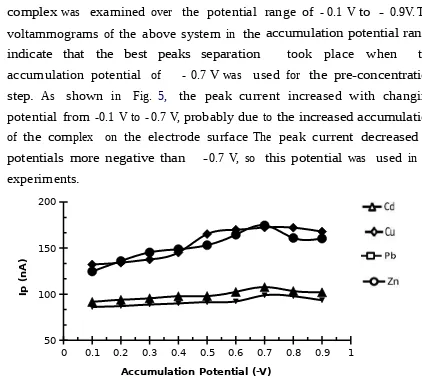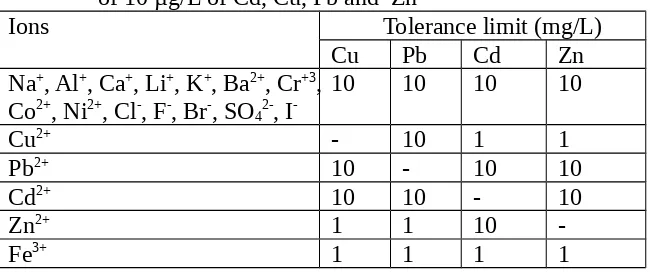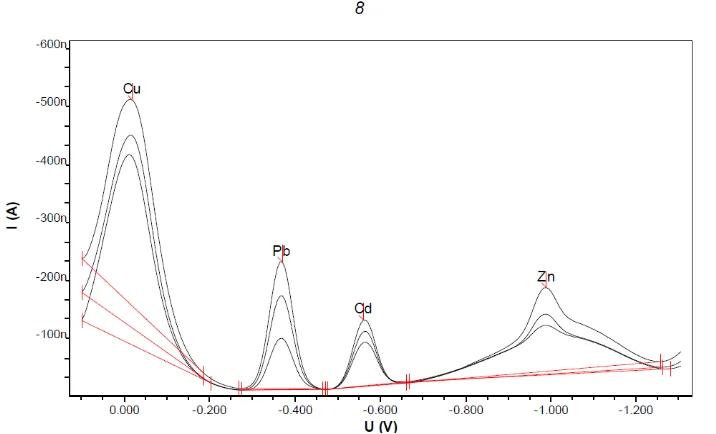INTRODUCTION
Over the last decade, Adsorptive Stripping Voltammetry (AdSV) has evolved into a very versatile and powerful electroanalytical technique. This method is aimed to extend the scope of the sensitivity and selectivity of stripping analysis toward numerous analytes (organic molecules and metal chelates exhibiting surface-active properties [1]. Besed on the wide range of applications reported during the recent years, the adsorptive concept appears to be the most universal stripping approach. When the given substance contains an electrochemically reducible or oxidisable group, the peak current on the voltammetric curve is recorded after completion of the accumulation period.
Electroanalytical procedures have been proposed for the determination of trace metals because they can be a valid option in the multicomponent analysis of several
species; they can also be used for natural water, especially seawater [2]. The sensitivity and selectivity of these methods can be improved either by the introduction of new types of electrodes or by the development of new analysis procedures. Electrochemical methods include stripping voltammetric techniques, principally anodic stripping (ASV) and adsorptive cathodic stripping (AdSV) voltammetry, which show numerous advantages, such as minimum sample pretreatment, high speed of analysis, good performance with saline matrix, low cost, and good selectivity and sensitivity [1,3].
The development of AdSV methods has allowed the determination of many trace
metals; this was not limited to amalgam-forming elements such as ASV. The method is based on the interaction between metal ion and a ligand, followed by the accumulation of the complex onto the electrode surface, from which it is subsequently stripped during the cathodic voltammetric scan. The ligand forms a complex with the target metal, which is adsorbed and later reduced on the electrode. The adsorption of the complex is often related to the solubility [4,5]. In addition, the size of the metal complex determines the surface coverage, and thus the sensitivity. Therefore, it is necessary to study the applicability of new ligands that may increase the sensitivity and selectivity of trace metal ion determination.
adsorptive collection of complexes, but there are only few studies about simultaneous metal determination [5-8].
These proposed methods use different ligands: for example, dimethyl glyoxime
[8] to detect Co, Zn, Cd and Ni, but with high detection limits (2.3 – 5.1 µg/L) or
substituted catechols [5] that lack much sensitivity (>5 µg/L). Moreover, a mixture of ligands has been proposed for the multi-elemental determinations of several elements
(Cu, Pb, Cd, Ni, Co and Zn) in seawater [4]. The detection limits of 0.2 µg/L for
Cu(II), 0.4 µg/L for Pb and 0.12 µg/ L for Cd were obtained using dimethyl glyoxime and 8-hydroxyquinoline as ligand by AdSV. Therefore, there is a great interest in developing new ligands with adequate complexing properties, which may perform the simultaneous determination of several metals at trace levels.
Trace heavy metals are very important in the environment due to their serious toxicity although present at very low concentrations. The presence of heavy metals in the environment, including food ingredients is very dangerous, because of high level of toxicity [9,10]. Adsorptive stripping voltammetry was chosen as an alternative method of analysis because it has many advantages such as: high salt content of sea water does not interfere, high sensitivity, low detection limit in ug/L, simple and easy sample preparation, rapid analysis, less infra structure [11,12]. In addition, with this method it is possible to learn chemical species of heavy metals [13,14] which can not be done with other methods.
pre-concentration time is short, generally less than one minute [22].
The present paper describes an adsorptive stripping voltammetry procedure for determination cadmium, copper, lead and zinc in water samples using Bis (N,N-bis(carboxymetyl)aminometyl) fluorecein or Calcein as a complexing agent. Calcein is important chelating agents because of their donor properties in coordinating metals and their ability to behave as polydentate ligands in neutral and deprotonated forms. They are widely employed for the fluorometric determination of
metals,[23] being good analytical reagents due to their metallochromic properties [24]. Because of their interesting properties, they can be applied in the determination of heavy metals by adsorptive stripping voltammetry [3].
This study was used calcein as a chelating agent for simultaneous of analysis Cd, Cu, Pb and Zn metals by adsorptive stripping voltammetry. The structure of calcein can be seen in Figure 1.
Figure 1. Structure of Calcein (Fluorexon)
To overcome the problem mentioned above a better condition of adsorptive stripping voltammetry is needed to get a selective and sensitive method. The parameters studied were: variations of calcein concentration, variation of pH solution, accumulation potential and accumulation time. To determine the precision, accuracy, sensivity and linearitas of method, relative standard deviation (RSD), recovery, limit of detection and correlation coefficient were determined. The method at optimum condition was applied for the direct determination of Cd(II), Cu(II), Pb(II) and Zn(II) in seawater around of Bungus and water tap.
EXPERIMENTAL
purchased from Merck and the aqueous solution of Cd, Cu, Pb and Zn 1000 mg/L was prepared by using the analytical grade Merck product.
The instrument used in this study were: 797 Computrace with Metrohm HMDE working electrode, a reference electrode Ag/AgCl/KCl 3 M and the Pt electrode as a counter electrode, pH meter models 80 Griffin (Griffin & George Loughborough, UK), analytical balance Mettler AE 200, Toledo OH-USA and glassware commonly used in laboratory.
Methods: The aim of this study was to obtain the optimum condition of each metal ion Cd, Cu, Pb and Zn by adsorptive stripping voltammetry. Therefore studied the effect of the following parameters namely, variations of concentration calcein of 0.2 mmol/L calcon to 0.9 mmol/L, variation of pH 3 to pH 9, accumulation potential of -0.2 V to -1.1 V and accumulation time variation of 20 s to 100 s. To determine the precision and accuracy of method relative standard deviation (RSD) and recovery were determined. Procedure used in this study according were reported previously [11].
Sample preparation: Sea water samples were obtained from a beach around Bungus, Padang City, West Sumatera, Indonesia. The samples were placed in plastic bottles
previously washed with 1 % HNO3 solution. In the laboratory they were filtered through
a 0.45 µm membrane filter and acidified with HNO3 to pH close to 2. Tap water samples were obtained from the laboratory, Department Chemistry Andalas University, river water were obtained from Lubuk Minturun Padang City. Before the analysis all the samples were digested by UV irradiation for 90 min at 90 °C (10.0 mL of sample with 100 µL of
30 % H2O2).
RESULT AND DISCUSION
and zinc) and calcein system. Four separated peaks for the reduction of cadmium, copper, lead and zinc complexes with calcein were observed that was due to the difference in the thermodynamic stability of their complexes. Comparison of the voltammograms revealed that height of the cadmium, copper, lead and zinc peaks depends not only on the duration of the preconcentration step but, in the presence and absence calcein, also the stripping initial potential,which revealed the adsorptive nature of the response [9].
Fig. 2. Adsorptive stripping voltammetry for Cd(II). Cu(II), Pb(II) and Zn(II)-calcein system.(a) Differential pulse adsorptive stripping voltammograms in mixed solution of Cd(II), Cu(II), Pb(II) and Zn(II) 10 µg/L in the absence of calcein. (b) the adsorptive stripping voltammmograms of mixture of metal ions (cadmium, copper, lead and zinc) in the presence calcein
.
In this work, a new sensitive and rapid adsorptive voltammetric method for simultaneous determination of ultra trace levels of cadmium, copper, lead and zinc was developed based on adsorptive stripping voltammetry of cadmium, copper, lead and zinc complexes with calcein
Effect variation of concentration calcein
experiment (Fig.3)
The inffluence of pH on the cathodic stripping peak currents of cadmium, copper,
lead and zinc was studied in the pH range of 3.0 – 9.0. It was found that at pH 4.0 the
peak currents of cadmium, copper, lead and zinc were at their maximum value. Thus pH
4.0 was adopted for further studied (Fig. 4). The decrease in the response for cadmium,
copper, lead and zinc, is due to competitive formation of metal hydroxide.
Condition : 10 mL mixed solution of Cd, Cu, Pb dan Zn 10 µg/L; 0.2 mL calcein 0.6 mM ; 0.2 mL KCl 0.1 M; accumulation time 60 s and accumulation potential -0.7 V
Effect variation of accumulation potential
The effect of accumulation potential on the stripping peak current of the complex was examined over the potential range of - 0.1 V to - 0.9V.The voltammograms of the above system in the accumulation potential range indicate that the best peaks separation took place when the
accumulation potential of - 0.7 Vwas used for the pre-concentration step. As shown in Fig. 5, the peak current increased with changing potential from -0.1 V to - 0.7 V, probably due to the increased accumulation of the complex on the electrode surface The peak current decreased at potentials more negative than -0.7 V, so this potential was used in all experiments.
0 0.1 0.2 0.3 0.4 0.5 0.6 0.7 0.8 0.9 1 50
100 150 200
Accumulation Potential (-V)
Ip
(
n
A
)
Figure 5. Effect variation of accumulation potential on peak current (Ip)
Condition : 10 mL mixed solution of Cd, Cu, Pb dan Zn 10 µg/L; 0.2 mL calcein 0.6 mM ; 0.2 mL KCl 0.1 M; accumulation time 60 s and pH 4
Effect variation of accumulation time
Fig. 6 shows plots of the cathodic peak current in adsorptive stripping voltammetry versus
accumulation time for cadmium, copper, lead and zinc. The time requared for
accumulation of the metal complex, with less time requared for higher concentration. At
inhibition of the chelate adsorption by competitive coverage by the free ligand. An
increase in the stripping peaks current with accumulation time was observed for Cd -, Cu,
Pb and Zn-calcein complexes. As is expected for adsorption processes, the dependence of
the peak current on the accumulation time is limited by saturation of electrode, resulting
in the current reaching a plateau at high accumulation times, as shown in Fig. 6
Thus, deposition time of 60 s was used throughout, as it combines good
sensitivity and relatively short analysis time.
10 20 30 40 50 60 70 80 90 100 110 100
150 200 250 300 350
accumulation time (s)
Ip
(
n
A
)
Figure 6. Effect variation of accumulation time on peak current (Ip)
Condition : 10 mL mixed solution of Cd, Cu, Pb dan Zn 10 µg/L; 0.2 mL calcein 0.6 mM ; 0.2 mL KCl 0.1 M; accumulation potential – 0.7 V and pH 4
Analytical figure of merit
Linear range and limit of detection: Under the optimized conditions, a linear relationship between the reduction peak current of the iron, cobalt, nickel and chromium complexes and the concentration of Cd(II), Cu(II), Pb(II) and Zn(II) was obtained. The result can be seen in Table 1. To verify the linear relationship between peak current and metal concentrations, four calibration curves were plotted under optimum conditions. The
calibration equation, obtained by least-squares method, is Ip = 3.936C +161.2 (r2 = 0.986)
Pb(II) and Ip = 2.521C + 113.5 (r2 = 0.985) for Zn(II) determination, where C is the concentration of metal ions (µg/L) and Ip is the peak current (nA). The stripping peak current of Cd(II)-calcein, Cu(II)-calcein, Pb(II)-calcein and Zn(II)-calcein complexes were found to be directly proportional to be the cadmium, copper, lead and zinc concentration in the range of range 0.2 -1 35.0; 0.2 - 110.0; 0.2 - 100.0 and 0.2 - 110.0 µg/L, respectively. The limit of detection is calculated of three times standard deviation of blank solution devided with slope (3SD/B) under optimum conditions were obtained: 1.021, 0.987, 0.972 and 0.957 µg/L of Cd(II), Cu(II), Pb(II) and Zn(II), respectively.
Table 1. Analytical parameters obtained for simultaneous analysis for Cd(II), Cu(II), Pb(II) and Zn(II) ions.
Relative standard deviation is used to look at the precision of the method is the same operating conditions. The determination of the relative standard deviation performed at optimum conditions have been defined above. At the optimum conditions with eight times replicates (n = 8) measurements of 10 µg/L standard solution of Cd(II), Cu(II), Pb(II) and Zn(II) were: 0.39, 0,74, 1.35 and 0.41%, respectively. According to the AOAC method, the value of relative standard deviation was smaller than 8 % at concentration of 10µg/L. That mean this method has a high degree of precision because the RSD obtained for each metals was smaller than 8 %.
Recovery:
can be seen in Table 2. That is, this method has high accuracy [25].
Table 2. Simultaneous determination of Cd, Cu, Pb and Zn in sea water Bungus, Padang City
Added(µg/L) Found (µg/L) Recovery (%)
Cu Pb Cd Zn Cu Pb Cd Zn Cu Pb Cd Zn
0 0 0 0 18,7±2.7 12,2±1,3 38,1±1.7 184,3±1.7 - - - -10 20 30 40 27,8±1.4 31,8±1,6 69,3±1.2 225,4±2.3 97 99 -102 -101 20 30 40 10 37,9±3,5 41,5±1.8 78,9±2.1 193,7±2.2 98 98 101 99 30 40 10 20 48,6±2.3 51,2±2.8 48,9±2.3 203,1±1.3 99 98 102 99
Interference studies
Table 3. Tolerance ratio of interfering ions in the determination of 10 µg/L of Cd, Cu, Pb and Zn
The proposed method was successfully applied for determination of cadmium, copper, lead and zinc in several water samples. The Cd(II),
recom-mended procedure under optimum conditions, using the standard addition method. The results presented in Fig. 8, show the high sensitivity of the proposed method
Fig. 8. Voltammogram of Cd, Cu, Pb and Zn in sea water samples from Bungus Padang. City
CONCLUSION
It can be concluded that the optimum conditions for the simultaneous measurement of Cd(II), Cu(II), Pb(II) and Zn(II) by adsorptive stripping voltammetry were : concentration of calcein 0.6 mM, pH 4.0, accumulation potential of -0,7 V (vs. Ag/AgCl) and accumalation time of 60 s. Under the optimum conditions the measurement peak current is proportional to the concentration of Cd(II), Cu(II), Pb(II) and Zn(II) in the range 0.2 -110µg/L ; 0.2 – 100 µg/L ; 0.2 – 110 µg/L ; and 0.2 – 100 µg/L respevtively. The limit of detection of the method was 1.3871 µg/L for Cd(II), 0.7663 µg/L for Cu(II), 1.4372 µg/L for Pb(II) and 0.9832 µg/L for Zn(II). The relative standard deviation were 0.84%, 0.25%, 0.43% and 0.54% for Cd(II), Cu(II), Pb(II) and Zn(II) for ten replicates (n = 10) measurements of mixture solution 10 µg/L of Cd(II), Cu(II), Pb(II) and Zn(II). The method was successfully applied for simultaneous determination of Cd(II), Cu(II), Pb(II) and Zn(II) in tap, sea water and lake water samples of Maninjau Agam, West Sumatra.
One of the authors (Deswati) would like to thanks to Directorate General of Higher Education, Ministry of Research and Technology, Higher Education who has funded this research in accordance with the Letter Agreement Implementation Fundamental Research Assignment Number : 003/UN.16/PL/D-FD/2014.
References
1. C. Locatelli and G. Torsi, Microchem. J, 65, 203 (2000).
2. J. Wang, “Stripping Analysis-Principles, Instrumentation and Application”, VCH, Deerfield Beach, (2006).
9. S. Abbasi, K. Khodarahmiyan and F. Abbasi, Food Chem, 128, 254 (2011). 10. H. A. Ahmed, M. Jamal, Am. J. App. Sci, 4, 594 (2009).
11. Deswati, H. Suyani and Safni, Indo. J. Chem, 12, 20 (2012). 12. S. Zang and W. Huang, Anal. Sci, 17, 983 (2001).
13. M.S. El-Shahawi, A.S. Bashammakh, A.A. Al-Shibaai, S.O. Bahaffi and E.H. Al- Gohani, Electroanal, 23, 747 (2011).
14. R. Jugade and A. P. Joshi, Anal. Sci, 22, 571 (2006).
15. S. Abbasi, K. Khodarahmiyan and F. Abbasi, Food Chem, 128, 254 (2011).
16. Deswati, H. Suyani, Safni, U. Loekman and H. Pardi, Indo. J. Chem, 13, 236 (2013). 17. A. Babaei, I. Shams and A. Samadzadeh, Anal. Sci, 22, 955 (2006).
18. F. M. Shemirani, A. Rajabi, Asghari and H. Milani, Can. J. Anal. Sci and Spect 50, 175 (2005).
19. A. Shahryar, A. Bahirae and F. Abbasai, Food Chem, 129, 1274 (2011)
20. N. Edgar, V. Arancibia, R. Rios and C. Rojas, Int. J. Electrochem. Sci, 7, 5521(2012). 21. Deswati, C. Buhatika. H. Suyani, Emriadi, U. Loekman and H. Pardi, Int. J. Res.
Chem. Environ, 4, 143 (2014).
22. M. K. Amini and M. Kabiri, J, Iran of Chem. Soc, 2, 32 (2005).


